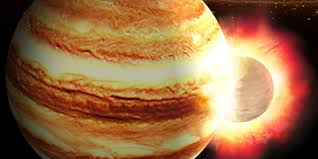An ancient impact with a planetary embryo changed the core of the gas giant forever.
Source: CNet
NASA’s Juno spacecraft has given us unreal views of the gas giant Jupiter. But Juno isn’t just a member of the interplanetary paparazzi, it’s a fully capable cosmic lab with instruments designed to probe the mammoth planet. After taking precise measurements of Jupiter’s gravitational field, the spacecraft has discovered that the planet’s core isn’t as dense as expected.
Now, scientists have proposed an almost-apocalyptic reason for this: A “planetary embryo” with 10 times more mass than Earth (and almost as much mass as Uranus) could have slammed into the largest planet in the solar system and disturbed its core. It’s not the object that whacked Jupiter last week and was captured by an amateur astronomer on Earth. This event would have taken place in the distant past, and we’re only just learning how it may have shaped Jupiter.
The research, published Wednesday in the journal Nature, details a number of simulations demonstrating how a planetary embryo could have led to the uneven distribution of heavy metals we see throughout Jupiter’s gaseous envelope today. Jupiter is mostly composed of hydrogen and helium gases that move around a dense core. Scientists believed that heavy metals should be confined close to a dense core, but the Juno mission revealed that the metals are actually strewn further from the core, making it more dilute.
“Jupiter’s interior models based on Juno’s data suggest Jupiter has a fuzzy core that extends to almost half of its radius, which no one has ever imagined,” says Shangfei Liu, lead author on the study and astronomer at Sun Yat-sen University in China.
How could that occur? The research team’s simulations suggest the young Jupiter suffered a giant impact during its formative years, which gave rise to this weird, unexpected distribution.
Though the collision sounds violent, it’s almost as if the young Jupiter swallowed up the planetary embryo. “A planetary embryo is a still-forming protoplanet, mostly made of rock and ice from the solar nebula,” explains Liu. The simulations show that the core of the protoplanet would have had to collide with Jupiter’s core to throw up the heavy elements and mix them throughout the entire envelope. The models show that the impact would have resulted in the internal structure discovered by NASA’s Juno and inthe heavy element distribution.
Other simulations demonstrate that if the smaller planet only skipped across Jupiter, the collision wouldn’t have the power to redistribute heavy metals throughout the gaseous envelope (though it would still be bad news for the baby planet).

These models also offer an explanation for some of the phenomena seen in a number of easily-discoverable exoplanets, the planets that lie outside our solar system. A number of these planets, known as “hot Jupiters,” are super dense, stacked with heavy elements and orbit very close to their star. They’re also prone to giant impacts. The researchers suggest their model might explain why there are so many heavy metals in these hot Jupiters, since they get smashed by planetary embryos as they form.
Could a series of small events, rather than one huge impact, give rise to the Jupiter we see today? The researchers say this needs more investigation.
The work provides further evidence of the tumultuous environment of the early solar system. Previous research suggests that massive impacts shaped our moon and Earth itself. The new research even suggests Saturn may have experienced a similar impact event during its formation and another NASA probe, Cassini, famously plunged into the planet’s interior in 2017.
“There are studies using Cassini’s data (especially during its grand finale) to model Saturn’s interior,” says Liu. “But Juno was designed to measure Jupiter’s gravity field, so the data is much better and models are more reliable. But Saturn’s interior is definitely worth to look at in the future.”
As for Juno? The Jovian explorer has been orbiting Jupiter since 2016 and recently had its mission extended to 2022, so we can expect more revelations ahead.

































Leave a Comment
You must be logged in to post a comment.